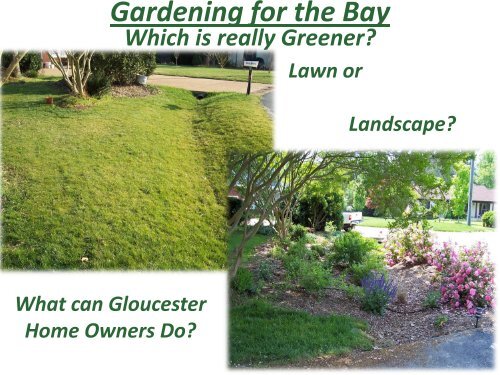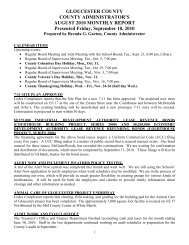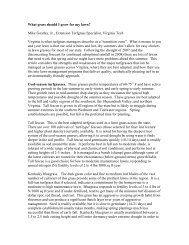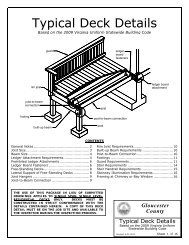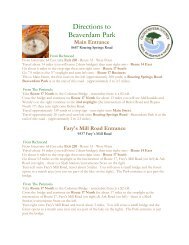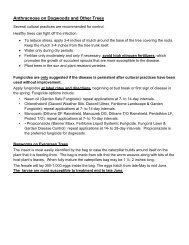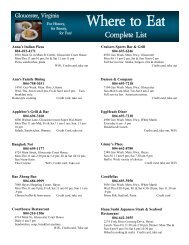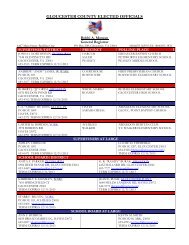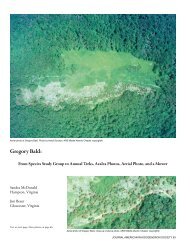Rain Gardens - Gloucester County Virginia
Rain Gardens - Gloucester County Virginia
Rain Gardens - Gloucester County Virginia
Create successful ePaper yourself
Turn your PDF publications into a flip-book with our unique Google optimized e-Paper software.
Gardening for the Bay<br />
Which is really Greener?<br />
Lawn or<br />
Landscape?<br />
What can <strong>Gloucester</strong><br />
Home Owners Do?
OUTLINE<br />
• What are the problems?<br />
- Polluted runoff.<br />
• Reducing lawn size and using native plants<br />
- Bayscaping.<br />
• Slowing erosion and buffering the streams and<br />
creeks<br />
- Riparian Buffers (RPA)<br />
• Reducing waste going into landfills.<br />
- Composting.<br />
• Using a garden to capture and filter rain water<br />
before it goes further into the water cycle.<br />
- <strong>Rain</strong> gardens
The Problem<br />
What<br />
Happens to<br />
<strong>Rain</strong>fall?<br />
Before 1507<br />
One house per acre<br />
More<br />
development<br />
leads to more<br />
Runoff.<br />
More Runoff<br />
means more<br />
pesticides,<br />
fertilizers, oil,<br />
petroleum<br />
and heavy<br />
metals in the<br />
Bay<br />
Courthouse &<br />
Newer Developments<br />
WalMart – Home Depot area
What are Homeowners Doing?<br />
Current Situation in US<br />
• 30 Million acres of lawn.<br />
• 100 Million tons of fertilizer<br />
• 80 Million pounds of pesticides<br />
–10 x as much as farmers per acre.<br />
•Grass clippings are 25-40% of<br />
landfills.<br />
•All these numbers are increasing<br />
In Chesapeake Bay area alone<br />
In next 25 years<br />
•3 Million more residents<br />
•750,000 less acres of forest or<br />
farmland. Source EPA
What can Homeowners Do?<br />
Current Situation in US<br />
• 30 Million acres of lawn.<br />
• 100 Million tons of fertilizer<br />
• 80 Million pounds of pesticides<br />
–10 x as much as farmers per acre.<br />
•Grass clippings are 25-40% of<br />
landfills.<br />
•All these numbers are increasing<br />
In Chesapeake Bay area alone<br />
In next 25 years<br />
•3 Million more residents<br />
•750,000 less acres of forest or<br />
farmland. Source EPA<br />
Possibilities<br />
1. Easy Steps that require very<br />
little effort<br />
2. Reduce size of lawns and use<br />
native plants. (Bayscaping)<br />
beside streams (Buffers)<br />
3. Make compost from yard<br />
waste<br />
4. Create <strong>Rain</strong> <strong>Gardens</strong> to<br />
capture and filter runoff.<br />
Degree of difficulty is higher
1. Easy Steps<br />
Possibilities<br />
• Mow at 3”, leave grass clippings on the lawn, but not in heaps.<br />
– Acts like mini compost - does not lead to thatch problems<br />
– Keeps lawn cooler<br />
– Reduces evaporation<br />
•Fertilize at the right time of year and the proper amount.<br />
–Fertilize warm weather grasses (turn brown in winter) in the spring only<br />
– Fertilize cool weather grasses (stay green in winter) in SON (Sept-Nov), but<br />
only a 1/3 application or less each per month.<br />
–Use organic fertilizer to replace chemicals, a little more expensive but<br />
better for the Bay<br />
• Fertilize your garden (& turf) area with compost<br />
– 2-3 inches, about a cubic yard per 150-100 square feet.<br />
– Brent Heath “Feed your soil with compost, and let your soil feed your<br />
plants.”<br />
– Instead of chemical fertilizer on turf, top dress with ¼-½ inch compost<br />
• Water in the morning & use drip irrigation to reduce<br />
evaporation in garden areas.
Possibilities<br />
2. The Next Steps<br />
•Reduce lawn size and increase use of native plants.<br />
This is frequently referred to as Sustainable Landscaping,<br />
Bayscaping, Green-Scaping and Earth-kind Landscaping<br />
Native Plants advantages<br />
• Have survived in this area for centuries without fertilizer, special<br />
care or supplemental watering.<br />
• These plants have far deeper roots than turf grass<br />
– Aids deeper penetration of rainfall & reduces runoff<br />
– Reduces erosion<br />
– Stabilizes slopes and banks<br />
• They provide food and habitat for birds and wildlife
Kentucky<br />
Blue<br />
Grass<br />
Goldenrod<br />
Big<br />
Bluestem<br />
Side Oats<br />
Grasses<br />
Little<br />
Bluestem<br />
Buffalo<br />
grass<br />
Heath<br />
Aster<br />
Indian<br />
Grass<br />
Compass<br />
Plant<br />
Purple<br />
Coneflower<br />
Switch<br />
Grass<br />
White/Blue<br />
Wild Indigo<br />
Courtesy of: Heidi Natura of Conservation Research Institute, and used by NRCS
Root variety points to importance of plant variety<br />
Courtesy of: Heidi Natura of Conservation Research Institute, and used by NRCS
A situation where we could and should reduce runoff.<br />
Lawn slopes steeply towards storm drain, which drains<br />
into Sarah’s creek. Did not want to mow or fertilize this<br />
area.
Rototilled the area and then raked out the large clods.
•Spread 2-3 inches of compost and tilled again.<br />
• Spread newspapers 3-4 sheets and covered with 2<br />
inches of wood mulch<br />
• Then set in the plants.
•Later that summer. Natives: Salvia, forsythia & dianthus,<br />
and some roses that have been identified as Earthkind TM<br />
by Texas A & M. Drip hose to reduce evaporation.
Earthkind Roses<br />
This is a designation given by Texas A & M to roses (and other<br />
plants) that have survived at least eight years in research fields<br />
spread across the length and breadth of Texas. After planting, and<br />
given some water in the first month, the roses receive no<br />
additional care, no fertilizers or pesticides chemical or organic.<br />
You have probably heard of some of the individual species such as<br />
Knockout Roses; however, there are twenty varieties in total that<br />
have earned this designation.<br />
The goals of Earth-Kind, Bayscaping or other forms of Sustainable<br />
Landscaping directions including Riparian Buffers are,<br />
–Water Conservation<br />
–Reduction of fertilizer and pesticide use<br />
–Energy Conservation<br />
–Reduction of Landscape Waste entering landfills
Resource Protection Area (RPA)<br />
Riparian Buffer<br />
Protection zone for rivers, streams etc<br />
Regulations permit owners to<br />
• Provide reasonable sight lines<br />
• Construct access paths<br />
• Manage woodlot<br />
• Projects intended to control<br />
shoreline erosion<br />
Regulations prohibit owners from<br />
• Building within 100 foot buffer<br />
area, if there is space outside<br />
this area.<br />
• This prohibits gazebos, sheds,<br />
pools etc in the buffer area.<br />
• Clear cutting the area<br />
• Filling or grading<br />
And discourages fertilizers or<br />
pesticides in the buffer area.<br />
Native Plants are more likely to be approved for buffer zone projects<br />
and fit within the regulations and recommendations.
3. COMPOSTING FOR HEALTHY GARDENS<br />
All vegetative material eventually breaks down. The time<br />
for this process depends on a number of factors:<br />
•Ingredient size: The finer these are chopped the better.<br />
•Mix: 6-8 inches of dry leaves to 2 inches of grass clippings.<br />
Avoid pine needles (too acidic)<br />
•Moisture: Lightly damp (not wet)<br />
•Turning frequency (from daily to once a week) you decide<br />
how much work you want to do and when you need it.<br />
• Exothermic: Should produce heat (when turned may<br />
smoke or may look like ashes inside. This is good!)<br />
•Volume: 3ftx3ftx3ft is sufficient (less will not have critical<br />
mass to generate the needed heat for the process.)
COMPOSTING FOR HEALTHY GARDENS<br />
1. Chop or shred coarse materials to increase surface area.<br />
2. Begin with 3-4 inches of coarser materials twigs or cut up corn<br />
stalks or shucks, these should be about 6-10 inches long.<br />
3. Then a 6-8 inch layer of kitchen refuse (vegetable material - no<br />
meat or dairy), leaves straw, weeds, coffee grounds, tea bags<br />
crushed egg shells etc.<br />
4. Now a layer greens: 2 inches if only grass clippings or manures<br />
(horse, chicken, cow) 2-4 inches if other green garden materials<br />
(no dog or kitten droppings) included.<br />
5. Repeat steps 2-4. Until the pile reaches 3-feet tall, but not higher<br />
than 4 feet .<br />
6. If you run short of greens or manures, you can replace that layer<br />
with ½ cup of 10-10-10 fertilizer and some soil.<br />
7. Dampen the mixture.<br />
8. Top with a tarp, soil or plastic cover to retain heat.<br />
9. Turn with pitchfork every few days to aerate mixture.<br />
10. Add additional materials in layers as pile cooks down.
COMPOSTING FOR HEALTHY GARDENS<br />
Carbon-to-N it rogen Rat io<br />
A blend of high carbonaceous material and high nitrogen<br />
material to give a steady 30:1 C:N ratio is ideal.<br />
Materials with high nitrogen values<br />
Vegetable Waste 12-20:1<br />
Coffee Grounds 20:1<br />
Grass Clippings 12-25:1<br />
Cow Manure 20:1<br />
Horse Manure 25:1<br />
Poultry Manure 10:1<br />
Pig Manure 5-7:1<br />
Material with high carbon values<br />
Foliage 30-80:1<br />
Corn Stalks 60:1<br />
Straw 40-100:1<br />
Bark 100-130:1<br />
Dried leaves 120-200:1<br />
Paper 150-200:1<br />
Wood chips 100-500:1
COMPOSTING FOR HEALTHY GARDENS<br />
Fast composting:<br />
• Have a good mix of browns (6-8<br />
inches dry leaves, shredded<br />
paper, dry garden waste, coffee<br />
grounds) to greens (2 inches<br />
grass clippings, fresh garden<br />
cuttings).<br />
• Turning daily 3-5 rotations.<br />
• If using a bin or simple heap a<br />
tarp or plastic cover can shorten<br />
composting period.<br />
• Compost can be ready in as little<br />
as 4-6 weeks during the summer.
COMPOSTING FOR HEALTHY GARDENS<br />
Slower composting:<br />
• Same mix of browns to<br />
greens.<br />
• Less frequent turning, once<br />
or twice a week.<br />
• If using a bin or simple heap<br />
a tarp cover can shorten<br />
composting period.<br />
• If kitchen waste is included,<br />
turn pile and/or cover with<br />
soil to reduce odor and<br />
varmint problems<br />
3-X FEET
4. <strong>Rain</strong> <strong>Gardens</strong><br />
<strong>Rain</strong> gardens are a way for homeowners, businesses as<br />
well as governments to participate in efforts to reduce<br />
polluted runoff, simply by planting specialized gardens to<br />
filter the water rather than having it merely run off.<br />
“Specialized gardens”- deeply prepared bed to capture<br />
runoff (slightly below grade level) using native plants that<br />
can survive well even after periods of drought or standing in<br />
water. The bed materials and plants are chosen because of<br />
their ability to filter pollutants out of the runoff water, such as<br />
fertilizers, pesticides, petroleum products and even heavy<br />
metals.<br />
This is becoming a popular way to reduce pollutants that are<br />
getting into the streams, rivers and the Bay.<br />
Many smaller rain gardens are more efficient and less costly<br />
than treatments centers.
An established rain garden in bloom. <strong>Rain</strong> <strong>Gardens</strong> intercept<br />
runoff before it reaches storm drains or streams.
Deeply<br />
prepared bed –<br />
The soil in the<br />
garden should be<br />
6-8 inches below<br />
the original slope.<br />
The bed itself<br />
should be 2-3 feet<br />
deep and filled<br />
with a mix of 50%<br />
sand, 30% topsoil<br />
and 20% compost.<br />
Many articles<br />
suggest the bed<br />
should be 10 feet<br />
across. But a<br />
smaller garden<br />
bed can still work.<br />
Note the berm on<br />
the down hill side.<br />
. .<br />
.<br />
. .<br />
.<br />
. .<br />
. .<br />
.<br />
.<br />
. .<br />
. . . ..<br />
. .<br />
. ..<br />
. . .<br />
. .<br />
.<br />
. .<br />
. . . ..<br />
. .<br />
. ..<br />
. . .<br />
. .<br />
.<br />
. .<br />
.<br />
. .<br />
.
Many sources of runoff: roofs (few gutters) and parking area<br />
or concrete walk and deck. The more impervious surfaces<br />
you have contributing runoff the larger the rain garden<br />
should be.
Guidelines for <strong>Rain</strong><br />
<strong>Gardens</strong><br />
• No closer than 10 feet<br />
to your foundation.<br />
From Wisconsin Department of Natural Resources.<br />
http://clean-water.uwex.edu/pubs/raingarden/rgmanual.pdf<br />
For this and more detailed information, see the suggested references in our handout.
After digging out the area, build berm on downhill side of the<br />
rain garden. Level the garden’s base and prepare for<br />
planting.
Usually it is best to place groups of 3 or 5 plants of the same<br />
kind and put in several different types of plants. Variety in<br />
plants and root structures is better for wildlife, and for plant<br />
and soil vitality.
<strong>Rain</strong> gardens are designed to pond for a few hours at a time.<br />
Ponding should not last over six hours. Jordan Cove, Urban<br />
Watershed Project, Waterford, CT.
Slope runs toward the rain garden.<br />
Grass slows the flow rate.<br />
The berm at back of the garden captures the water so it will not<br />
runoff
A Parking Lot Demonstration by the VDOF
<strong>Rain</strong> <strong>Gardens</strong><br />
Can be pretty and interesting: Some recommendations for<br />
<strong>Virginia</strong> by VDOF<br />
Joe Pye Weed Jerusalem Artichoke Great Blue Lobelia<br />
VDOF also recommends daylilies, red twig dogwoods, red<br />
maples, red or bald cypress. A list is included in our<br />
handout.
We have<br />
Choices<br />
These<br />
Or This
A <strong>Rain</strong> Garden to Capture Runoff from the Parking Lot and<br />
from the slope.
Advice for Making a <strong>Rain</strong> Garden<br />
• Call Miss Utility<br />
• Choose a site at least 10 feet from your foundation and down<br />
slope from a downspout.<br />
• A garden at a border looks better than a an oval in the middle of<br />
a yard.<br />
• Remove sod in an area of 150 square feet or more.<br />
• Bed should be 6 inches below original slope.<br />
• If you soil is sandy you may only need to dig down 8-10 inches.<br />
• If your soil is heavy clay you may need to excavate up to 3’.<br />
• Use some of the removed soil as a berm on the downhill sides.<br />
• Make sure bottom is level.<br />
• Fill with 50% sand, 25-30% topsoil and 20-25% compost.<br />
• Plant with native plants (plus daffodils and daylilies.)<br />
• Top dress with 2 inches of wood chip mulch.
• VT Resources<br />
• http://pubs.ext.vt.edu/426/426-713/426-713.html Creating a Water Wise Landscape<br />
• http://pubs.ext.vt.edu/426/426-722/426-722.html Reducing Erosion and Runoff<br />
• http://pubs.ext.vt.edu/452/452-231/452-231.html Compost: What Is It and What’s It To You<br />
• http://pubs.ext.vt.edu/426/426-704/426-704.html Using Compost in Your Landscape<br />
• http://pubs.ext.vt.edu/426/426-703/426-703.html Making Compost: From Yard Waste<br />
• http://pubs.ext.vt.edu/426/426-043/426-043.html Urban Water Quality Management:<br />
<strong>Rain</strong> Garden Plants<br />
• http://pubs.ext.vt.edu/426/426-041/426-041.html Urban Water Quality Management:<br />
What Is a Watershed? What You Can Do<br />
• Other Resources<br />
• http://www.npwrc.usgs.gov/resource/plants/cattail/stromsta.htm<br />
• http://plants.usda.gov/<br />
• http://www.fws.gov/ChesapeakeBay/Bayscapes.htm<br />
• http://www.dgif.virginia.gov/habitat/habitat-at-home/bayscapes.pdf<br />
• Native Plants for Wildlife Habitat and Conservation Landscaping<br />
Chesapeake Bay Watershed US Fish and Wildlife Service<br />
http://www.nps.gov/plants/pubs/chesapeake/<br />
• http://www.arec.vaes.vt.edu/hampton-roads/gardens/bayscape-garden/index.html<br />
• http://www.bae.ncsu.edu/topic/raingarden/<br />
• http://www.nrcs.usda.gov/feature/backyard/
http://www.dof.virginia.gov/mgt/resources/pub-<strong>Rain</strong>-Garden-Tech-Guide_2008-05.pdf<br />
http://www.dnr.state.wi.us/ORG/WATER/WM/dsfm/shore/documents/rgmanual.pdf<br />
http://www.nrcs.usda.gov/feature/backyard/BkYrdHit.htmlhttp://www.nrcs.usda.gov/feature/<br />
backyard/BkYrdHit.html Printed copies of this colorful 28-page booklet on Backyard<br />
Conservation and tip sheets are available free by calling 1-888-LANDCARE (single copies only).
Help <strong>Gloucester</strong> stay Green<br />
and save the Bay


